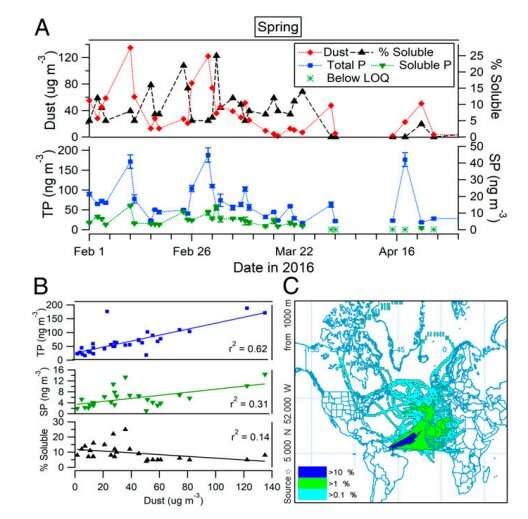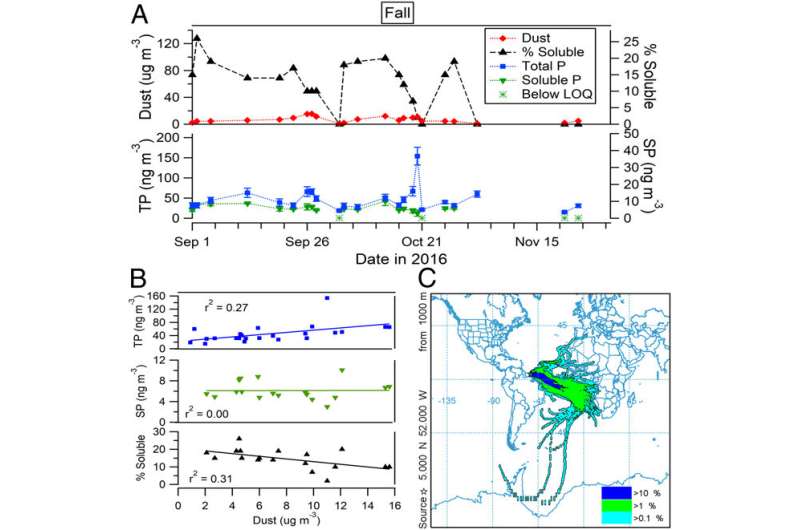August 14, 2019 feature
Smoke from Africa fertilizes the Amazon and tropical ocean regions with soluble phosphorous

A new study reveals that soluble phosphorus that fertilizes the Amazon, as well as the Tropical Atlantic and Southern oceans, is deposited through smoke from biomass fires in Africa.
The University of Miami's (UM) Rosenstiel School of Marine and Atmospheric Science conducted a study that found nutrients in aerosols carried from the African continent by wind are depositing up to half the phosphorus necessary to keep the Amazon Basin fertile, which in turn provides the vigorous biodiversity and productivity to sequester significant amounts of atmospheric carbon dioxide. Additionally, these aerosols fertilize the Tropical Atlantic and Southern oceans (TAO), sustaining the phytoplankton that is the basis of the marine ecosystem.
Previous studies had long ago revealed that dust carried from the Sahara and other desert regions of Africa supplied dense nutrients to South America. The study's senior author Cassandra Gaston, an assistant professor in the Department of Atmospheric Sciences at UM's Rosenstiel School, sums it up neatly: "It had been assumed that Saharan dust was the main fertilizer to the Amazon Basin and Tropical Atlantic Ocean by supplying phosphorus to both of these ecosystems. Our findings reveal that biomass burning emissions transported from Africa are potentially a more important source of phosphorus to these ecosystems than dust."
That's an impressive finding, and it took considerable work and careful tracking to arrive at it. The team measured windborne dust, phosphorous (P) and soluble P from a coastal site at the edge of the Amazon's northeastern edge. Additionally, winds originating from the African continent were tracked using satellite data. As it happens, the dust-carrying wind is not heavily fortified with soluble phosphorous, but instead supplies the regions with the majority of their low-solubility (about 5 percent) P through boreal spring (February through April).
In boreal fall (September through November), when dust deposits are lower, the research team recorded unexpectedly high levels of soluble P, which they discovered originates in biomass fires in Southern Africa. Identifying the source of the Amazon and TAO regions' soluble P was crosschecked through multiple means: first, through satellite images that showed aerosols from Africa on high-soluble-P measurement days. Again, the coloration of the samples on those days was usually gray, or grayer than at other times of the year, indicating the presence of burned materials. Third, air mass back trajectory (BT) analysis showed all high-soluble-P aerosols originated from air masses that had passed over the Sahara and the Sahel where biomass burning is active, providing evidence that this burning contributed to the higher levels of soluble P.

Biomass burning emissions have long been considered primarily destructive in terms of air quality, but are also known to contribute to the new growth of grasslands and forested areas (particularly those with certain varieties of pine trees, which have seed cases that only open after exposure to extreme temperatures). This study, however, revealed an unknown benefit of large fires, and explains how a region such as the Amazon Basin, where the heavy year-round rainfall leaves the soil nutrient poor, can remain so densely fertile and productive. It also helps researchers identify an important nutrient source for marine ecosystems in the region, which rely on marine phytoplankton.
The study's lead author, UM Rosenstiel School graduate student Anne Barkley, admits that the study's results are surprising: "To our surprise, we discovered that phosphorus associated with smoke from southern Africa can be blown all the way to the Amazon and, potentially, out over the Southern Ocean, where it can impact primary productivity and the drawdown of carbon dioxide in both ecosystems."
More information: Anne E. Barkley, et al. African biomass burning is a substantial source of phosphorus deposition to the Amazon, Tropical Atlantic Ocean, and Southern Ocean, PNAS 2019. DOI: 10.1073/pnas.1906091116
Journal information: Proceedings of the National Academy of Sciences
© 2019 Science X Network





















